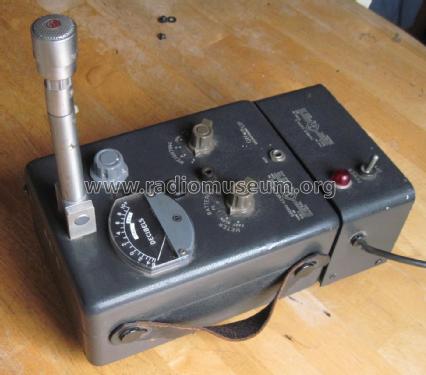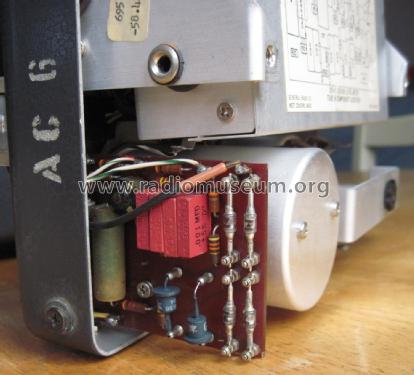Sound-Level Meter 1551-C
General Radio Company; Cambridge (MA)
- Pays
- Etats-Unis
- Fabricant / Marque
- General Radio Company; Cambridge (MA)
- Année
- 1968
- Catégorie
- Appareils de mesure et de dépannage (matériel de labo)
- Radiomuseum.org ID
- 279903
-
- alternative name: GenRad
Cliquez sur la vignette du schéma pour le demander en tant que document gratuit.
- No. de tubes
- 6
- No. de transistors
- 1
- Semi-conducteurs
- 2N1372
- Principe général
- Amplification audio
- Gammes d'ondes
- - sans
- Tension / type courant
- Batteries / Alim. BT séparée avec fiche / D: 2 x 1.5 & 67.5 Volt
- Haut-parleur
- - Pour casque ou amplificateur BF
- Matière
- Boitier métallique
- De Radiomuseum.org
- Modèle: Sound-Level Meter 1551-C - General Radio Company;
- Forme
- Portative > 20 cm (sans nécessité secteur)
- Dimensions (LHP)
- 7.25 x 9.25 x 6.125 inch / 184 x 235 x 156 mm
- Remarques
-
A Battery powered Sound-level meter that can be used as a calibrated audio amplifier.
Sound-Level Range: From 24 to 150 dB (re 20 μN/m2).
Frequency Characteristics: Four response characteristics, A, B, C, or 20 kHz, as selected by panel switch. The A-, B-, and C- weighting positions are in accordance with USA Standard S1.4, 1961 and IEC Publication 123, 1961. Frequency response for the 20-kHz position is flat from 20 Hz to 20 kHz, so that complete use can be made of very wide-band microphones such as the 1551-P1 Condenser Microphone Systems.Microphone: GR Type 1560-P5 (a piezo type). The 1551-P1 Condenser Microphone (an Electret with no internal FET buffer?) was an option, but a piezo type microphone was usually supplied.
Sound·Level Indication: Sound level is indicated by the meter and attenuator readings. The clearly marked, meter covers a span of 16 dB with calibration from -6 to +10 dB.
The attenuator is calibrated in 10-dB steps from 30 to 140 dB above 20 μN/m2.There are 7 semiconductor diodes as well as the transistor:
- 4 x 1N34A (D1 to D4)
- 2 x 1N645 (D5, D6)
- 1 x 1N967B (RX51), which is a Zener diode.
The rear has soft mounts and the main amplifier PCB has also soft rubber anti-vibration mounts.
Batteries
The 1.5 V LT is 2 x D Cells powering separate filament circuits. The CK512AX are in series-pairs being 0.625V filaments.
The HT pack was commonly used in 1950s small and Personal Sets, the Eveready / NCC 467 or any equivalent. The mains power supply unit 1262-C is an optional extra that is screwed on, the 120V / 240V switching is a soldered wire inside!
Filament batteries (LT 2x D-cells) should last 6 to 7 days at 8 hours a day, or 30
to 35 days at 2 hours a day. The 67.5V HT battery should last 12 to 14 days at
8 hours a day, or 60 to 70 days at 2 hours a day.There is a long life button cell mounted inside the amplifier unit under the PCB. It's used to bias the input amplfier grid at -1.4V. The manual is confusing: undo the amplifier cover (two screws). Then unscrew the two pillars the screws used. The PCB can then swing down. Next pull off the spring clip. The cell simply unscrews as it has an integral bolt! Any Silver Oxide cell of a similar size will do once you've made a custom holder. Make sure -ve goes to clip and +ve to the wire leaving the amplifier case. Do not use Zinc Air as they self-discharge. An Alkaline Manganese will work, but not as good as the silver cell. A lithium cell is too high a voltage (3V).
Output: 1.4 V (panel meter at full scale). The output can be used to drive analysers, recorders, oscilloscopes, and headphones. Harmonic distortion (panel meter at full scale) <1 %.
Input Impedance: 25 M Ohms in parallel with 50 pF. The microphone uses a Cannon plug / Socket so an external signal (30 microvolts) can feed the amplifier or a different microphone.
Army technical bulletin TB 9-4931-413-50 "Calibration procedure for Sound-level meter, General Radio, models 1551C, 1565A and 1565B"
- Poids net
- 7.75 lb (7 lb 12 oz) / 3.519 kg
- Source
- -- Original-techn. papers.
- Littérature
- -- Original-techn. papers.
- Auteur
- Modèle crée par Gottfried Silberhorn. Voir les propositions de modification pour les contributeurs supplémentaires.
- D'autres Modèles
-
Vous pourrez trouver sous ce lien 241 modèles d'appareils, 212 avec des images et 131 avec des schémas.
Tous les appareils de General Radio Company; Cambridge (MA)
Collections
Le modèle Sound-Level Meter fait partie des collections des membres suivants.

























